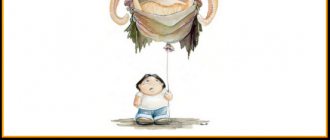What is a method?
Fairytale therapy is a method of psychological influence on a person that promotes the development of a person’s personality, creative abilities, correction of individual problems, as well as relieving tension, due to the accumulation of which psychosomatic disorders appear.
Many people believe that fairy tale therapy is used when working with children, but this is not true. It can be called “childish” only because it affects the childish nature of a person, his inner child .
In order for an adult to agree to fairy tale therapy, the psychologist must establish close contact with the client. Basically, this skill is possessed at a high level by experienced psychologists with extensive experience in the field of psychological counseling.
In this case, the patient will not be embarrassed and the result of work in this direction will be positive. Therefore, before a psychologist begins to work with fairy tale therapy, he needs to learn how to establish contact.
The main tool of this method is a fairy tale or parable . The events of a fairy tale evoke emotions in a person, and the characters and their relationships are projected by the patient onto his own life.
It often seems to a person that this situation is very similar to the one that is happening to him.
Thanks to a fairy tale, the patient can solve his problems. Fairytale therapy is used for individual and group work.
The advantage of fairy tale therapy in the second type of work is that a person from other group members receives new ways to solve a particular problem that were not previously open to him.
In order for the client to have a positive attitude towards this way of working with his problem, the therapist first turns it on inadvertently .
This is due to the fact that many adults categorically refuse this type of work, considering fairy tales meaningless.
You can work with a fairy tale in several ways :
- Analysis and discussion of a fairy-tale situation.
- Tell a fairy tale to one person or to several.
- Tell a fairy tale, and then come up with a sequel to it, and the last teller must complete the story.
- Group creation of a fairy tale.
- Telling a fairy tale from the first person (heroes) with their preliminary distribution among group members.
- Rewriting fairy tales.
- Staging a fairy tale using puppets or as a performance.
- Drawing fairy tales, i.e. While reading, the patient is asked to imitate what he imagines.
Fairytale therapy allows you to form a fresh look at the situation and reflect the patient’s internal conflict.
Fairytale therapy as a technique includes two stages: awareness of the situation in which the client is and therapy, i.e. solving a client's problem.
Fabulous changes
Nastya came to the next session beaming. In a new dress, new shoes and with a thick notebook.
She told Yulia that her dad approved of her decision to go to school, and she had already begun to prepare for the entrance exams. True, she decided to enroll in the correspondence department, but dad was still happy.
On this occasion, they went to the store, and then drank lemonade and ate cakes in a cafe. It turns out that Nastya’s dad has long wanted his daughter to dress according to her age, and not her mother’s.
- What about mom’s clothes? — I washed it, ironed it, carefully packed it and put it in the closet. I realized that I don’t have to wear it to remember my mother.
Then Nastya showed her notebook. Recipes were written down there. On one page there is “Mom’s” recipe for a dish, on the other there is “Nastin’s”.
The girl got a taste for it and started trying to cook something new. I found time to go to the hairdresser while the clothes were drying after washing and trimmed my hair.
— Mom’s were they long? - No, she had a short haircut and always neatly styled. Mom and dad always wanted me to cut my hair short. But I love long hair! “The Little Mermaid,” Julia smiled.
In response, Nastya asked her to open the notebook from the middle. There was her homework, which was finally done.
What is it used for?
Fairytale therapy is used to correct:
- Emotional-volitional sphere: combating fears, anxiety, aggressiveness, low self-esteem.
- Intrapersonal and interpersonal conflicts.
- Relationships between spouses, children and parents.
- Psychosomatic diseases (coronary heart disease, gastrointestinal pathologies).
- Relationships in teams.
- Mental illnesses (depression, panic attacks, anxiety-phobic disorders).
In addition, thanks to fairy tale therapy, you can prepare a person for intense stressful situations. After working through possible problems and their solutions, it will be easier for a person to bear the problem.
If a person, as a result of analyzing a fairy tale, is unable to determine a way out of the problem, then in any case he can build a more correct strategy of behavior to prevent the recurrence of the same situation in the future.
Fairytale therapy allows you to develop a person’s creative abilities .
Thanks to this, he becomes more relaxed with the people around him.
Very often, fairytale therapy is carried out with older people, especially those who find themselves in a boarding house.
Many studies have been conducted on this matter and a positive effect has been confirmed : patients become more cheerful and gain strength for further existence.
The general goal of fairy tale therapy is to correct behavior and get rid of fears that are embedded in the unconscious.
When working with adults, fairy tale therapy is used to determine a person’s character and reveal his essence. This can be done by reading and discussing an existing fairy tale. Those. in this case we can talk about the diagnostic function of fairy tale therapy.
However, fairy tale therapy allows you to restore a person’s faith in a positive outcome of the problem. If the patient resists when working with a psychologist and does not open up completely, then a fairy tale is used so that this energy is directed towards the person’s reflection.
Cinderella, princess...
For example, you can’t improve your personal life or meet a man.
Ask yourself what you are doing for this. Sleeping Beauty and Assol patiently waited for the handsome prince to come and save them from all troubles and problems. Likewise, the best years can be spent waiting for someone to come and do everything for you.
Or maybe you, like Andersen’s little mermaid, simply dissolve in your lover, completely subordinating your time and energy to him. And he leaves you for an obvious bitch, who was captivated in childhood by the tricks of the little robber or the fox Alice.
Of course, the plots of fairy tales do not always flow into adulthood. Often only a piece is embodied, some passage in which you involuntarily get stuck.
For example, you, like Cinderella, work tirelessly in anticipation of a miracle. You try to be good, try for others. But the prince is still not on the horizon.
And where will he come from if you yourself have not yet become a princess. Perhaps you just don’t yet live up to his ideas of a beautiful ideal. So become her, because Cinderella became a princess, at least for a while.
This popular tale is played out in many life scenarios. How many beautiful princesses, having married a prince, then become an addition to the household in the near future.
If you have subconsciously taken on the image of a sufferer, then do not be surprised that all your men over time begin to push you around, becoming sort of energy vampires.
Of course, sometimes it’s worth remembering your favorite books and being inspired to take on deeds in the field of home comfort, if there’s a mountain of dirty dishes in the sink, and you’ve become fused with your laptop and can’t remember the last time you cleaned.
People don't play roles all the time. The influence of fairy tales on the subconscious is not so great.
It’s just that sometimes, under certain life situations, these programs begin to activate, and not only in relationships with loved ones. They can influence career success, relationships with friends, colleagues and loved ones, even attitudes towards money. But sometimes they give you the strength to get through difficult situations.
Goals
In fairy tale therapy, several types of fairy tales are used, which are suitable for adults and differ from each other in their purpose of influencing the client :
- Psychocorrectional , the purpose of which is to correct a specific psychological problem, i.e. finding a way out of a problem situation.
- Psychotherapeutic , affecting a person’s relationship with the environment and himself, as well as affecting the human psyche and containing wisdom (parables, legends).
- A meditative fairy tale that helps relieve a person’s tension after stressful situations.
It can also be used after a hard day at work. The important point is that the narrator must have a certain timbre of voice so that a person can be completely immersed in the tale.
Irina Badanova, practicing psychologist - about fairy tale therapy
Hello, friends!
The human brain consists of two hemispheres. The left is responsible for logic, and the right for the emotional-imaginative sphere. In the modern world, people are accustomed to using almost exclusively the left hemisphere, ignoring the right.
This gives an advantage in learning and performing applied tasks, but it greatly impoverishes our daily life, deprives it of color and light, flattens our feelings, deprives us of the opportunity to enjoy both the process and the result, find a non-standard way out of a difficult situation, and establish rich emotional relationships with loved ones.
Fairytale therapy is a very lively and pleasant method that allows you to find a direct path to unconscious needs and resources, bypassing many psychological barriers. The heroes of fairy tales do not feel like such, they do not know that people from another world are interested in them.
Just imagine that your life can also be a fairy tale for someone. Who you are? The Enchanted Princess, Baba Yaga, Ivan Tsarevich or the Gray Wolf? A dragon with three heads or a little mouse? Are you going to seek your fortune across the three seas or are you guarding treasures? Are you performing a feat to save your betrothed or are you waiting for deliverance? Are you leading a squad into battle, solving a mystery, or languishing in a dungeon? Do you own a magic item, or are you the item yourself, magical or unusual?
Like Andersen, even a simple match can tell the story of life and death. Through a fairy-tale image you can understand a lot about yourself. What am I, what do I need? What are my strengths and weaknesses? What brought me to this place, to this situation. What am I hoping for, and can I get it in real life?
Fairytale therapy not only deepens our knowledge about ourselves, but can also help us see the situation from a different angle and find an unexpected and elegant solution. There are many examples when a fairy tale helped to get through the most difficult moments in life. Identifying with your favorite character allows you to try on his best qualities. And it’s not a sin to use this for both adults and children; it’s not for nothing that masquerades, reenactment fights, cosplays and the like are so popular among adults.
There was a time when each of us perceived the world as a miracle. Of course, we are talking about childhood. Then we experienced disappointment, parting with the fairy-tale world, like the heroes of “The Chronicles of Narnia”, who stand in front of the door to the real world. But time after time they return to a fairyland to find a resource to continue ordinary life, to find themselves.
Psychology invites you to visit this wonderful world of childhood, the world of fairy tales, where there is a place to meet the innermost and the opportunity to work hard and receive a generous reward. Good luck, dear friends, the wind is coming through the crack, the door is ajar, would you like to come in?
Principles
Practicing psychologists identify several principles of fairy tale therapy:
- Providing information about life values.
- The principle of life force. It lies in the fact that the patient, turning to a psychologist, suffers from a lack of vitality, and that is why he cannot independently change his life. With the help of a fairy tale, the client can restore his strength, i.e. accumulate internal resources.
- Versatility, characterized by the fact that the psychologist examines the fairy tale from different angles. Thanks to this principle, the patient begins to look at some problematic situation from different points of view.
- The connection between mental and social reality.
Rewrite your childhood settings. Write your story
In order not to repeat hackneyed scenarios, you need to rewrite them.
Which, by the way, is what many directors and animators do. Walt Disney's Little Mermaid has nothing in common with Andersen's Little Mermaid. So you, as a real programmer, can write any scenario for your life. As you know, thought is material. Play through your new story in your head. Take steps to implement your plans. Dispel past illusions. Maybe the prince is very close, you should take a closer look at those around you.
Examples of fairy tales for adults and older people
Psychologists for fairytale therapy suggest using folk tales, which allow the client to convey life experience.
Examples of psychological fairy tales for both adults and older people include:
- "Rock Chicken";
- "Kolobok";
- "By magic";
- "The Tale of Rejuvenating Apples and Living Water."
In addition, you can also use original fairy tales , such as “The Little Mermaid” (H.-H. Andersen), “The Christmas of the Beasts” (M.-L. Ver).
Some manuals for practical psychologists on fairy tale therapy provide other examples depending on the problem and the age of the person.
In the manual T.D. Zinkevich-Evstigneeva “Workshop on Fairytale Therapy” in the appendix you can see a fairy tale for older people who have problems with adults, called “The Old Queen”.
You can find a large number of psychological fairy tales on the Internet. They can also be used to work with patients.










